Wakayama Farm is an exceptional place in Utsunomiya, a city that can be reached in one hour by Shinkansen from Tokyo. Despite its name having the word “farm,” Wakayama Farm is home to the last carefully tended bamboo forest in Japan. A few years ago, it started welcoming visitors on its ground.
Its owner Taro Wakayama tells us about the rich history of this forest, what makes bamboo so unique, how it is linked to societal problems, and why he wants people to know and love bamboo.
A Long Familial History
What kind of place is Wakayama Farm?
Wakayama Farm is located in Kunimoto, a place in the northern part of Utsunomiya. Further north is Nikko. It is an agricultural field and a bamboo forest of 24 hectares.
In this area, water used to be scarce for a very long time. In Japan, cultivating rice fields, which use a lot of water, has always been the base of agriculture. People used to pay their taxes in rice. Not being able to create rice fields meant life was tough. My ancestors moved here 350 years ago because, at the time, there was a plan to create a new river as a means to bring water. However, it took more than a hundred years for the project to finally start. My ancestors did their best cultivating these fields where there was so little water and managed to grow all sorts of products. They ended up not being interested in rice fields anymore. With time, they became farmers who specialized in bamboo shoots and chestnuts.
My grandfather went to Utsunomiya University before the Second World War, where he studied modern agriculture. It was very unusual for the time. He was sent to fight during the war and thankfully came back alive. After the war, he improved the cultivation of bamboo shoots and chestnuts in Japan.
Bamboo shoots are harvested in spring and chestnuts in autumn. To make bamboo shoots, you need to have a bamboo forest and carefully maintain it by cutting the bamboo trees. At the time, Japanese people used bamboo to make all sorts of things, so it was possible to sell cut bamboo to make a living during winter. My grandfather popularized this way of cultivating both chestnuts and bamboo to make a living all year round. He was very famous for chestnut cultivation. So much that people came from all over Japan to learn from him before starting to grow chestnuts.
Then, it became harder during my father’s time to sell chestnuts in Japan because chestnuts imported from China and Korea were cheaper. So, my father decided to concentrate on cultivating bamboo. Though, my father was more of a scholar than a businessman. He was able to create a new sort of bamboo, a smaller version of Moso bamboo. Moso bamboo is known as the typical Japanese bamboo, gorgeous and very high.
There are now many modern buildings in Japan, and the architecture has lost its Japanese spirit. I have been advising to use bamboo as a modern way to create a Japanese atmosphere.
Now, I am doing my best to take care of this legacy. My family members are not enough to take care of the fields, and I need some employees. But the earnings we make only by selling chestnuts and bamboo shoots are not enough to pay the wages. So, I have popularized the bamboo that my father created through landscaping. I used to be a landscaper in Tokyo.
There are now many modern buildings in Japan, and the architecture has lost its Japanese spirit. When people want to make a place look more Japanese, using greenery is the easiest way. But pines, for example, do not go well with modern buildings. Conversely, bamboos, which are very straight and completely green, fit very well with concrete or glass. I have been advising to use bamboo as a modern way to create a Japanese atmosphere. Thanks to that, now you can see bamboo when you land at Haneda Airport or Narita Airport, in many hotels in Tokyo, or around big companies’ buildings. 90% of these bamboos are my creations. Thanks to this part of our business, Wakayama Farm can do many things today. Recently, we have also opened our bamboo forest as a tourist attraction to visitors.
The Last Bamboo Forest in Japan to Be Cared For
-1024x683.jpg)
How did you get the idea to invite visitors to walk in your bamboo forest?
To keep this huge bamboo forest clean to make bamboo shoots, we have to work all year round. There is not a single day off. We pick the bamboo shoots; we make potted plants. We also sell bamboo as a material. But I have always wondered if we could do anything more. I wondered if we could take advantage of the location of the space here.
Since I was a little boy, my grandfather used to say he wanted to make a summer resort out of this place, like Karuizawa or Nasu. At the time, I thought it was impossible. After growing up here and being here every day, the scenery has become ordinary. However, when I look at it as if for the first time, I realize it truly is beautiful. On top of that, there are no well-managed bamboo forests in Japan anymore. Nobody cuts bamboo anymore because we stopped making objects out of them.
There are bamboos everywhere in Japan, but the last well-maintained bamboo forest is here. There are indeed beautiful bamboos in tourist places in Kyoto and Kamakura. Still, they can be maintained thanks to the financial support from Japan or the local prefecture. Other sites have disappeared.
Since this is the last beautiful bamboo forest, it is often used as a location for movies, TV series, or commercials. Rurouni Kenshin: The Legend Ends was filmed here. They filmed a sequence in which the main character played by Takeru Sato and his swordmaster, played by Masaharu Fukuyama, train and fight together. They used our bamboo forests on one of the movie posters, and they put Wakayama Farm in the end credits. After that, fans of the two actors came to the filming location on a pilgrimage. At the time, it was not officially open to visitors yet. 20 or 30 fans would come to visit on Sundays, which was my day off. I would go still half-asleep to meet them. Since they had come all the way, I would let them walk in the forest. I was not charging any fee yet.
When fans came to visit, they first asked me if I had talked with the actors and how they were. But after visiting the bamboo forest, they did not talk about it at all. They were going home saying, “What beautiful bamboos!” I saw people of all ages, especially young people, enjoy our bamboos, and I realized that this place could make people happy. That is what convinced me to open it to visitors.
Sometimes we need the point of view of people from the outside to be reminded of things’ beauty.
You are right. For me, this scenery has become ordinary. However, I love it! Every morning, I walk my dog here for half an hour, and every day, it is beautiful.
We want people to grow to love bamboo trees. That is why we allow people to walk freely among them and touch them.
When did you open the forest to visitors?
Four years ago. In the beginning, we partnered with a big travel company to organize bamboo shoots harvest experiences. I asked them for advice, saying I would like people just to visit the place, and they said it sounded promising. We started like this, I was the guide, and it was a huge success. We got more and more groups visiting us. It was right at the time Tochigi Prefecture was doing a big promotional campaign to attract people. Then, three years ago, we opened the forest to groups and independent visitors.
How is Wakayama Farm different from popular tourist spots such as Arashiyama in Kyoto or Hokokuji Temple in Kamakura?
Arashiyama is a lovely place, with bamboos on each side of the path. However, there is a bamboo fence, so it is impossible to enter the forest or touch the bamboo trees. Also, it is extremely popular, so it is crowded most of the time. People want to touch the bamboo, so they take a detour to go on the other side, but the other side is not tended, probably because of a lack of resources. Kamakura’s Hokokuji is gorgeous, but its surface is only as wide as our parking space! The temple’s head priest is my friend, though, so I will not criticize too much [laughs].
Kyoto and Kamakura are places with beautiful culture and history, and we cannot win regarding this aspect. However, regarding the bamboos, we can. Our forest is beautiful and the widest. Visitors can also walk in the forest, touch the bamboo trees, and drink matcha green tea in bamboo cups that they can take back home. We want people to grow to love bamboo trees. That is why we allow people to walk freely among them.
-1024x683.jpg)
Do you see a difference in what foreign visitors like about the bamboo forest and what Japanese visitors like?
We only have had a few foreign tourists so far, before the pandemic. We have more and more foreign residents who come to visit though, and they seem very happy.
I cannot speak English, but my son and another staff member can. According to them, there is not a big difference in reactions. They all say it is beautiful, no matter their nationality of origin. A difference, though, is that foreigners are often interested in the history of the place. Japanese visitors usually do not ask about it.
Bamboo: A Tree like No Other
If the forest is not tended, it becomes so crowded with trees that it is impossible to walk in it.
What are the specificities and the beauties of bamboo trees?
In spring, bamboo shoots appear. From the moment it appears on the ground’s surface to its fully grown shape, it takes only two months. We have recorded a bamboo tree that has grown 1.2 meters high in a single day. Other trees grow and get thicker very slowly but can live for dozens or hundreds of years. Bamboo trees, after reaching their highest point in two months, just stop growing. Then, after 10 years, they die. In a way, they are more like herbs with a very long stem. Botanically, they are classified as Gramineae.
Since they die after 10 years and new ones keep growing to replace the old ones, if the forest is not tended, it becomes so crowded that it is impossible to walk in it. Dead bamboo trees start piling up, too. That is why we keep cutting them all year long.
Since we keep enough space between the bamboo trees, the leaves lighted by the sun are very bright and gentle green when you look up. The light itself becomes green. When the wind blows, it makes a very smooth sound, like waves. Listening to this sound, without thinking about anything else, is my favorite thing in the world.
Digging up bamboo shoots is exhausting work, so sometimes we sit or lie on the ground to rest. In such moments, the bamboo forest is the most beautiful. I would love for everyone to lie on the ground like this, but most people do not want to [laughs]. So, I got the idea to install hammocks between the bamboo trees. During these moments, when we stop doing anything, we can fully experience the bamboo trees’ beauty.
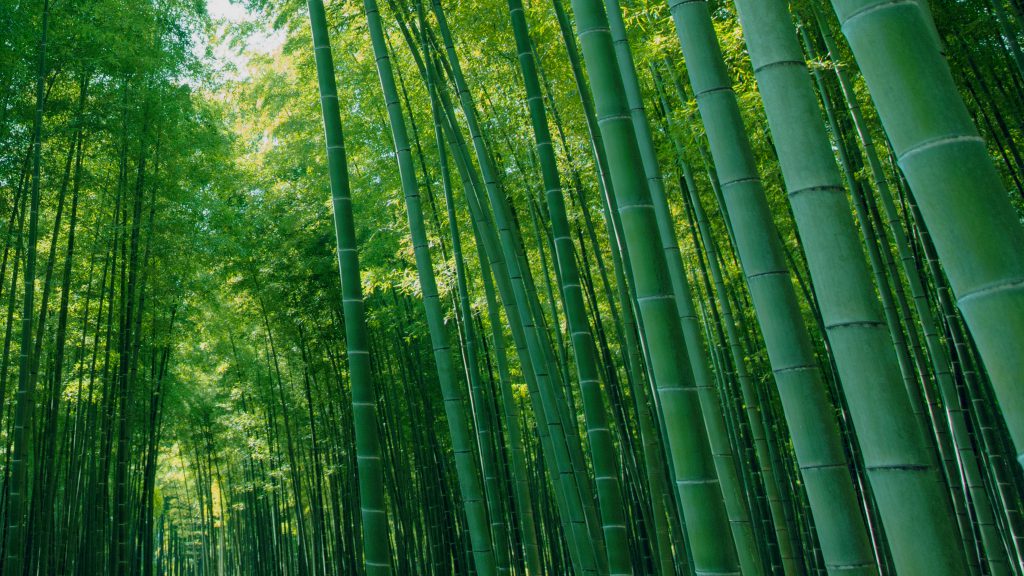
What kind of objects used to be made from bamboo?
Things for the kitchen or everyday life, such as baskets, laundry poles, colanders. Many items that are made from plastic today used to be made from bamboo. Plastic is cheaper, convenient, and never gets mold, so it gradually replaced bamboo. Today, such bamboo baskets or colanders have become a luxury. They are more for display than everyday use.
Bamboo is great for sustainability, and I think it will be considered a treasure in the future.
Maybe people will want to start using bamboo again for ecological reasons. Plastic is the cause of terrible pollution, but bamboo is sustainable.
You are right. It is also good regarding gas emissions. Bamboo trees, being plants, absorb carbon dioxide, and release oxygen. Using bamboo objects would also help reduce carbon dioxide in nature. Petroleum will disappear someday, but bamboos keep growing and can be used as a material in just a year. It is great for sustainability, and I think it will be considered a treasure in the future. We can even make towels, clothes, and paper from bamboo. Many big companies are currently researching its different uses.
Making People Know and Love Bamboo
What is the main message you want to convey at Wakayama Farm?
We want people to touch and come to love bamboo. Most of all, we want visitors to take their time to walk in the forest. But after walking a lot, you get tired, so there is a space where you can relax and drink matcha green tea in a bamboo cup. The hammock, too, comes from this idea—to take your time and relax among the bamboo trees.
During winter, you display illuminations called “Bamboo Winter Lights.” How did you get the idea to use the bamboo forest as a place for year-end illuminations?
First of all, we do not only use illuminations; we also light the bamboos up. We put them into the light. We wanted to show that bamboos are also beautiful at night.
When we started opening the forest to the public, almost all the people who came were elderly. But once we began to light them up at night, young people started coming, too. They were taking a lot of pictures to put on their Instagram accounts.
Then, in winter, we also display illuminations in many forms. There is a short show during the lighting up of the bamboos and it changes colors according to music. There are also special illuminations for which we carve bamboos and put lights in them. This comes from the Japanese tradition of using bamboo as lanterns because the inside of bamboos is not green but almost white, reflecting light very well.
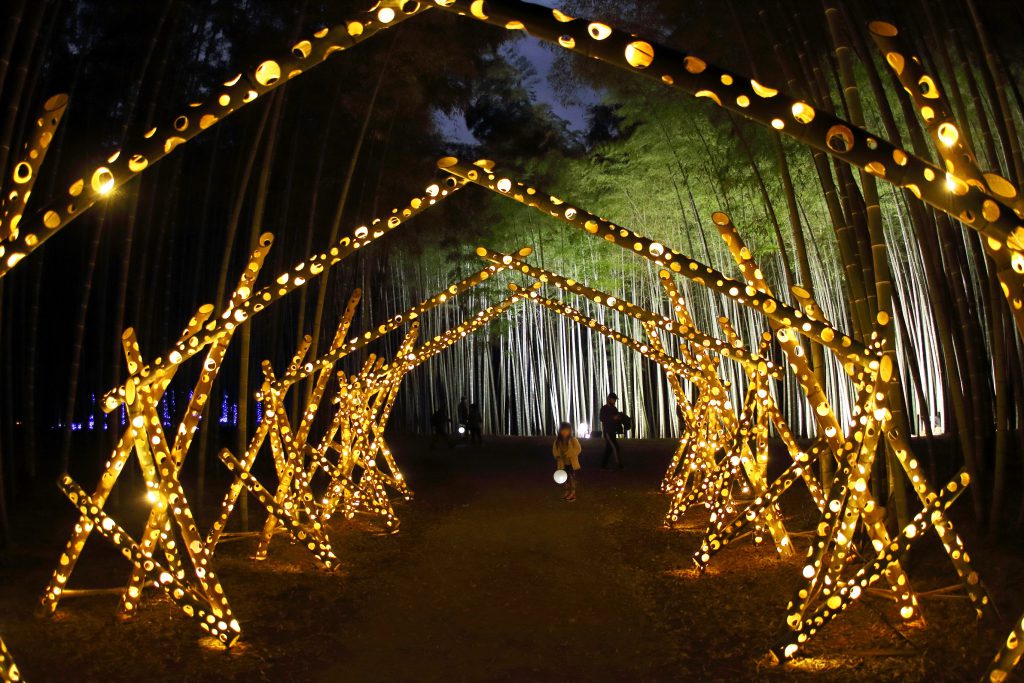
Festivals are displaying such lanterns in many places in Japan. In Kumamoto, after the huge earthquake a few years ago, more than 1,000 people gathered together through social media. They created such a festival to get money for reconstructing the area. It was a huge success. So, I thought it would be great to display such lights in the bamboo forest. However, I did not want to create something too traditional, but to create something Japanese and modern at the same time. I wanted something that reflected the current Japan and future Japan.
It seems that your family has always been trying to do new things. Your grandfather tried new techniques learned at university. Your father created a new kind of bamboo, and you are also finding new ways for people to enjoy bamboo.
Maybe you are right! I cannot do such scientific research, though. But I want people to enjoy this space that my family has developed and this land that my ancestors have protected for generations.
Do you have any other original side activities involving bamboo?
We are trying to sell bamboo as a material, but we are still not very good. For now, we transform it into compost so that farmers use it as fertilizer. We also use bamboo to make cages for the aquaculture of oysters.
We are also trying to produce menma, the seasoned bamboo shoots you see in ramen noodles. Most of them are produced in Taiwan and China. It is made from a sort of bamboo that can be grown only in tropical environments. That is why there is no menma made in Japan. However, bamboo has a specific smell that young Japanese people resent. Now we are trying to create a new sort of menma that would smell different from Japanese bamboo. If we cut a young bamboo that has only grown a little and eat it, it has the same texture as menma. Since last year, we have been working on developing this as a new product with a menma company. It is under testing right now.
In newspapers, they have started using a new word, ‘chikugai,’ which can be translated as ‘damage by bamboo.’ It makes me very sad.
What are your objectives for the future?
I did not have such intention, but I have become a representative for the Japanese bamboo, and now I have to assume it. Wakayama Farm’s objectives are to make people touch and know bamboo, feel close to it, and love it.
There are still many wild bamboos everywhere in Japan, which keep taking more and more space and are growing very fast. Other trees die and it is becoming a social problem. In newspapers, they have started using a new word, “chikugai,” which can be translated as “damage by bamboo.” It makes me very sad.
These bamboos were initially planted and cut by people as they wished, and now they are left abandoned as these same people wished. This is not the bamboo’s fault. It is humans’ fault. But the bamboos are considered troublesome.
I wish we could make people like bamboos, make them want to take care of these bamboos everywhere in Japan, and have beautiful bamboo forests around. I am thinking of other ways to educate people about bamboos. For example, I am thinking about making people stay for the night in the bamboo forest. We would use specific hammocks that have a ceiling like tents. This way, the soil would not be damaged. It is an example of the many things we are thinking of doing now.

Exploring All Possibilities
I personally had the chance to visit Wakayama Farm, and I can confirm it is a beautiful place, both day and night. It was unlike other famous bamboo places I had the opportunity to visit in Japan so far. This is where I met Mr. Wakayama for the first time, and listening to him passionately talk about bamboos and his family history made me want to hear more.
Through my other activities involving tourism in Japan, I had the opportunity to learn a lot about the challenges that the countryside must face. I often meet older Japanese people who would like to attract visitors and new residents but are quite at a loss on how they should do it. Many people have been running businesses the same way for years and have a hard time coming up with new ideas.
In such a context, Wakayama Farm looks even more special. Considering his grandfather and father’s careers, it seems like the spirit of innovation runs in the Wakayama family. They are not afraid to try new ways of working, developing new ideas, and showing them to people.
Nowadays, bamboos are perceived as a threat to the environment in Japan. However, I believe they can become a handy tool for ecology and sustainability. I wish we could go back and replace many plastic objects with bamboo ones. Hopefully, more people will get to know and appreciate the many qualities of bamboos soon.

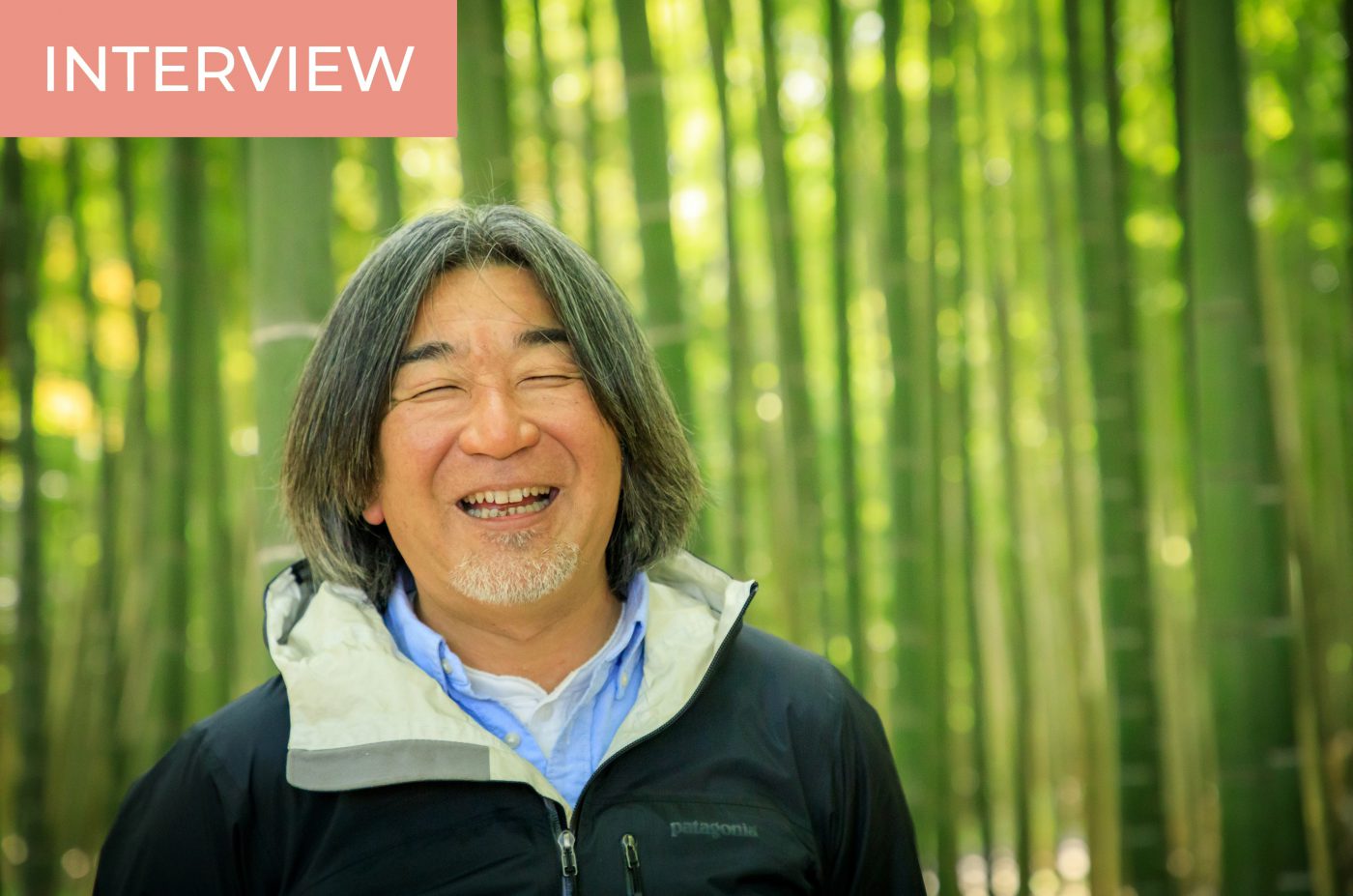
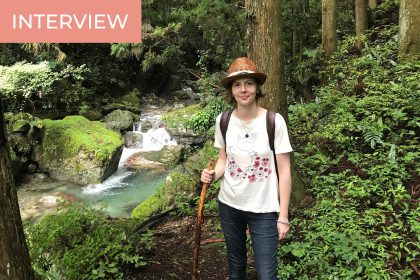
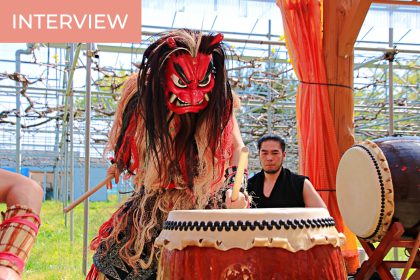
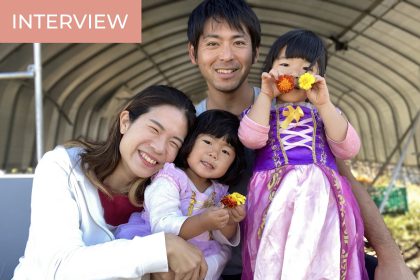
2 Comments
stacy kurokawa
April 11, 2023 at 9:48 AMI heard bamboo is a grass. I too am curious about what to do with the spreading untended dark bamboo groves – there are so many near where I live. I used to live in Utsunomiya, for almost two decades, and I visited Wakayama Farm for a community event to drill holes into cut bamboo to make lanterns. Now I see this has caught on across Japan, and beautiful illuminations events result. I hope bamboo can be used to make paper and cloth in Japan in the future.
Amélie Geeraert
May 2, 2023 at 10:23 AMHi Stacy,
Thanks a lot for your comment and sharing your experience with Wakayama Farm. I hope bamboo will be used for many everyday items too!